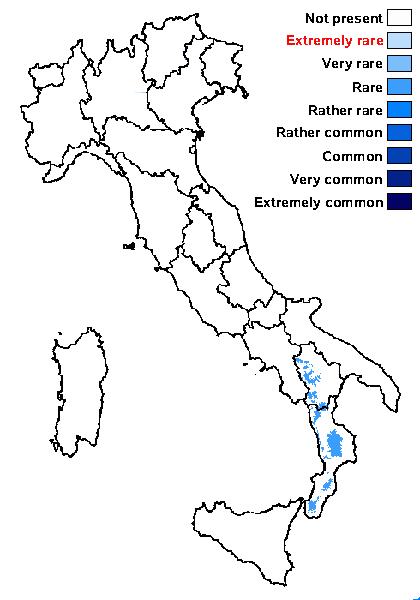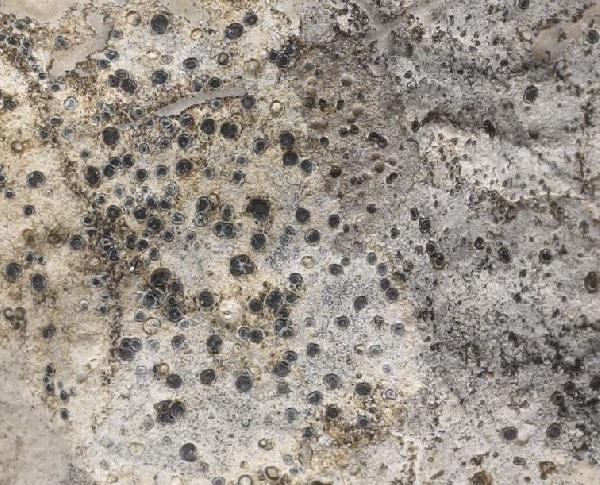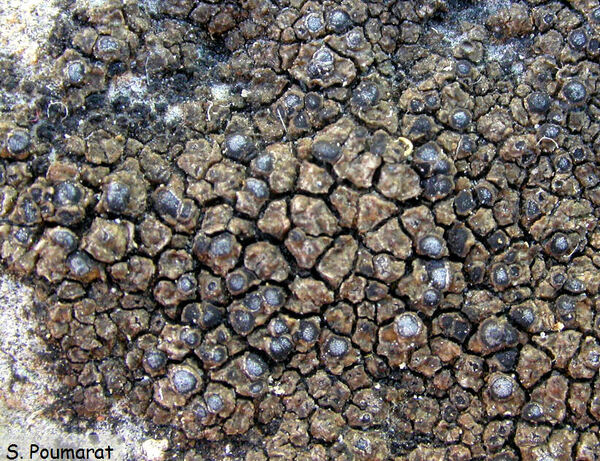Rinodina luridata (Körb.) H. Mayrhofer, Scheid. & Sheard
Bibl. Lichenol., 38: 346, 1990. Basionym: Buellia luridata Körb. - Parerga Lichenol.: 188, 1860.
Synonyms: Kudratovia luridata (Körb.) S.Y. Kondr., Lőkös & Hur; Rinodina euryspora Zahlbr.; Rinodina iodes H. Mayrhofer & Poelt; Rinodina iodes var. immersa H. Mayrhofer & Cl. Roux
Distribution: S - Bas, Cal.
Description: Thallus crustose, whitish, ochraceous to medium brown, quite variable, continuous and endosubstratic or episubstratic and rimose-areolate, the areoles 0.5-0.8 mm wide, flat, smooth or somewhat rugose, without a distinct prothallus. Apothecia lecanorine to rarely pseudolecanorine, 0.3-0.5(-0.7) mm across, immersed in the rock to subsessile, with a concave to slightly convex, dark brown to black, at first often whitish-grey-pruinose disc, a thin, entire, persistent to partly excluded thalline margin, and a rather thick, entire, persistent proper margin. Thalline exciple (40-)60-120 µm wide, corticate; proper exciple 10-15 µm wide laterally; epithecium red-brown, K-; hymenium colourless, not inspersed with oil droplets, 70-90(-100) µm high; paraphyses 2-3.5 µm thick at mid-level, the apical cells 4-6 µm wide, with a dark cap; hypothecium colourless to pale yellow, 70-100 µm high. Asci 8-spored, clavate, the K/I+ blue tholus penetrated by a faintly amyloid apical cushion with parallel or diverging flanks, the wall K/I-, surrounded by a K/I+ blue outer layer, Lecanora-type. Ascospores 1-septate, brown, broadly ellipsoid, (10-)11-14(-15) x (6.5-)8.5-9(-11) µm, Bicincta-type, the outer wall not ornamented, thickened at septum and apices in young spores, the lumina soon rounded, with a pigmented band around each cell, with ontogeny of type A (apical wall thickening after septum formation). Photobiont chlorococcoid. Spot tests: thallus K-, C-, KC-, P-, UV-. Chemistry: thallus with zeorin. Note: on sun-exposed calcareous outcrops in upland areas; certainly present also in the Alps.
Growth form: Crustose
Substrata: rocks
Photobiont: green algae other than Trentepohlia
Reproductive strategy: mainly sexual
Commonnes-rarity: (info)
Alpine belt: extremely rare
Subalpine belt: very rare
Oromediterranean belt: rare
Montane belt: rare
Submediterranean belt: absent
Padanian area: absent
Humid submediterranean belt: absent
Humid mediterranean belt: absent
Dry mediterranean belt: absent

Predictive model

Modified from: https://gzu.jacq.org/GZU000286087
GZU000286087 as Rinodina iodes var. immersa - C. Roux - 1980-12-20
Location France
Label Var entre Bargemon et le Plateau de Canjuers, immédiatement au-dessous et au S du Col du Bel Homme. ; Alt. 1000 m
Habitat Surfaces de petits blocs (calcaire compact du Jurassique supérieur) peu élevés au-dessus du sol, dans une pelouse rase. Pente: 0-60° S á SW. Association: Verrucarietum marmoreae typique (cf. Roux, 1978: 100-101, relevé no. 6)
Growth form: Crustose
Substrata: rocks
Photobiont: green algae other than Trentepohlia
Reproductive strategy: mainly sexual
Commonnes-rarity: (info)
Alpine belt: extremely rare
Subalpine belt: very rare
Oromediterranean belt: rare
Montane belt: rare
Submediterranean belt: absent
Padanian area: absent
Humid submediterranean belt: absent
Humid mediterranean belt: absent
Dry mediterranean belt: absent

Predictive model

 Index Fungorum
Index Fungorum
 GBIF
GBIF




